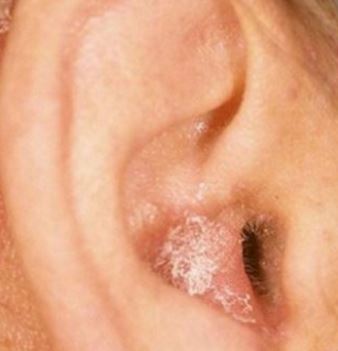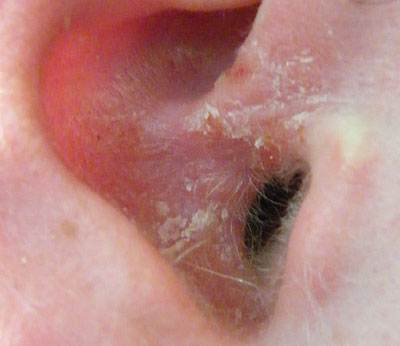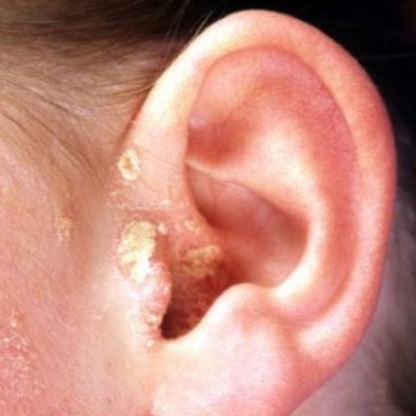A scab in the ear that won’t go away could be a sign of ear infections. Scabs in your ear canal that are recurring, feel crusty and painful or have blood should be a reason enough to see an ENT. Black, red and white scabs in the ear canal, earlobe and in-ear piercings or earring hole may be painful and result in a lot of discomforts.
Ear problems can range from pimples, zits, fluid and discharge that may indicate a problem developing. While some of the symptoms may show in the ear canal, others show on the earlobe, on piercings and earring holes. What causes scab in the ear? Why do they hurt and won’t heal for a long time?
Causes of ear scabs and sores
The causes of dry crusty ear scabs can be many things, some of which should be worrying while others should not worry you. A painful scab in your ear, or any formation that hurts or causes discomfort should be reason enough to see an ENT. Here are the causes of scabs in the ear canal, earlobe and on ear piercings.
1. Psoriasis in ear and scabs in the ear that won’t go away
Psoriasis is a medical condition that “changes the life cycle of skin cells” [Mayo Clinic] and causes them to build up fast on the surface of the skin. These cells can form anywhere in your ear and cause discomfort. You are likely to get an itchy feeling, which may result in dry patches inside your ear.
When you touch the thick, dry patch of skin in your ears, you will feel some pain and sometimes find them red or bleed from the scratching caused by fingers. According to Mayo Clinic, “there isn’t a cure, (but) psoriasis treatments may offer significant relief.” The recurring nature of scabs or the scab in the ear that won’t go away are a result of psoriasis.
2. Infected pimple inside the ear canal
Pimples, zits or bumps in the ear often cause discomfort. This is likely to make you start picking the pimple. Cystic acne, for example, can be stubborn to pop even when it is on the ear fold, earlobe or even behind the ear.
An open pimple inside your ear is likely to get infected if not cleaned and/or treated well. Infected spots in the ear may become itchy, irritated and sometimes discharge pus, blood or a yellow fluid that settles to form a scab inside the ear canal.
3. Ear cancer can form a scab on earlobe and fold
Cancer of the ear is a life-threatening condition and should be treated as early as possible. According to Ear Q on Diseases and Abnormalities of the ear, cancer of the ear may show the following symptoms, which should be properly diagnosed and treated.
- An irregular scabbed area in the skin, usually crusty, jagged and oozing. This symptom may be present for a long time since the scabs won’t heal, will repeatedly bleed and ooze from time to time.
- Flat, scaly or crusty flesh-colored or brown patch inside the ear.
- A white, way scab, which may be a sign of invasive and disfiguring ear cancer, which is a type of basal cell carcinoma.
4. Ear scab on piercing or earring hole
Freshly pierced ears can easily get an infection. While they heal, a scab of pus or blood may form on the surface of the piercing. This should be cleaned gently using rubbing alcohol to prevent further infection and allow healing on its own.
If the scab on ear piercing doesn’t go away, you should see a doctor for treatment. Some ear piercing problems such as keloids start developing slowly if the earring hole does not heal properly. Also, any injury or tear caused by an earring should be treated properly to prevent it from turning into a big bump inside the ear.
5. Bacterial and yeast ear infection
Scabs behind ears and head may also be caused by bacterial and yeast infections. Itchy ears without a discharge that is crusty could be an indication of an infection inside the ear canal. Oral and topical antibiotics are used to treat them and get rid of the ear scabs and sores. Keep in mind that if left untreated, these sores can spread and damage your eardrum, and further cause hearing loss.
Scab in the ear canal that won’t heal, painful
A crusty and painful ear canal scab could be caused by wax buildup that tags onto the skin and ends up forming a small, painful lump. However, in some cases, you may have a scab inside ear canal that won’t heal for a long time.
If the scab is white in color or red, it could mean a serious health problem such as cancer. Ensure you see a specialist for proper diagnosis or biopsy to determine if it is cancer growing in your ear canal or not. Do the same for a painful scab in the canal of your ear, especially if it is oozing blood or pus and obstructs hearing.
Scabs behind ears, dry, white, crusty and hurts
An irritated scab behind ears can easily hurt especially if you pick it. Dry skin is common in babies with cradle cap in their ears. If your baby has a dry scab behind his ears, it could simply mean that they have a dandruff-like skin on their ears. This can be removed with baby shampoo at home, though you should have a doctor look at it first.
Caster.com reports that if you have mites, you are likely to scratch yourself behind ears and cause small cuts that can develop into small sores. If the sores continue being itchy, you can easily get bleeding or a small wound from the physical trauma that you apply on the sores.
Treatment for Scabs in Ears
Treatment will depend on the cause of the problem. As we have seen above, all the causes are unique and may require different treatments to get rid of the recurring crusty, dry, white, painful and bloody scabs inside the ear.
Let it fall off on its own. If the scab inside your ear is not a serious problem and does not recur over and over again, leave it alone to fall off on its own. That is probably the best treatment for a one-time blood scar in the ear.
Prescription medication for ear psoriasis. Psoriasis does not have a conclusive treatment, but you can be managed with prescription medication. Some doctors prescribe normal topical treatments that are used for the scalp. This treatment only helps soften the dry scaly scabs to make them fall off or clear. You might need to use them repeatedly to manage the condition. Some common medications include anti-itch treatments such as hydrocortisone, keratolytics for lifting scales, Salicylic Acid, coal tar and many other OTC treatments.
Treatment for cancerous scabs in the ear canal may involve the surgical removal of parts of the middle ear to prevent spreading of the affected cells and to stop the growth.
Pets such as cats and dogs may have this problem as well. Dogs and cats are known to easily get mites and fleas. These attack the ears a lot and cause sores and scabs in dog ears or cat ears. Have a vet treat your pet if it has any of these symptoms.
References and Sources:
- Mayo Clinic: http://www.mayoclinic.org/diseases-conditions/psoriasis/basics/definition/con-20030838
- http://www.mayoclinic.org/diseases-conditions/basal-cell-carcinoma/basics/symptoms/con-20028996
- Ear Q: http://www.earq.com/hearing-loss/ear-anatomy/diseases
- http://www.internationaleczema-psoriasisfoundation.org/scalp_ear_psoriasis.php4



4 comments
I don’t think you should of pulled it off. It will just scab over again, Not funny!!
Yeah, probably not the best idea to pull it off… But I think it ‘s human nature if you have some thing wierd on you to get it off ASAP. Need to see a ENT Doc right away.
Cut an onion into a shape that will allow easy removal and use it as an ear plug for a few nights in a row. Garlic is a little too powerful.
Idk bro’s. All i know is that i bleed through my earz on’a daily basis. (: